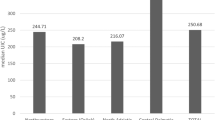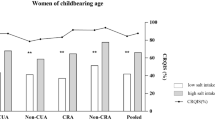Abstract
Objective: The most accurate way to measure urinary iodine excretion in epidemiological surveys is still debated. We propose a new principle of estimating iodine excretion based on casual urine samples.
Material and methods: A total of 123 24 h urine samples and corresponding casual urine samples were collected from 31 subjects. Iodine excretion was expressed as 24 h iodine excretion and three different estimates: iodine concentration in the casual sample, iodine/gram creatinine in the casual sample, and the new principle—iodine/creatinine ratio in the casual sample, adjusted for expected creatinine excretion of the individual.
Results: All three estimates based on casual urine samples correlated significantly to 24 h values with a r (Pearson) of 0.37 for iodine concentration, 0.61 for iodine/creatinine ratio and 0.62 for the age- and sex-adjusted iodine/creatinine ratio. The median iodine excretion in the entire group was 143 μg/day in 24 h samples, 87 μg/l as iodine concentration, 77 μg/g creatinine as iodine/creatinine ratio and 126 μg/day as age- and sex-adjusted iodine/creatinine ratio.
Conclusion: Age- and sex-adjusted iodine/creatinine ratio is a more accurate and unbiased estimate of iodine excretion in epidemiological surveys of adults than the two most frequently used estimated: iodine concentration and iodine/gram creatinine, as these two estimates may introduce a bias depending on the composition of the investigated group. The adjusted iodine/creatinine ratio is superior to the other estimates, especially when individual estimates of 24 h iodine excretion is required or cohorts of selected groups are investigated.
Sponsorship: This work was supported by grants from the Medical Research Foundation Region Greater Copenhagen, Faroe Islands and Greenland; the Wedell-Wedellsborg Foundation; Musikforlæggerne Agnes and Knut Mørks Foundation.
European Journal of Clinical Nutrition (2000) 54, 361–363
This is a preview of subscription content, access via your institution
Access options
Subscribe to this journal
Receive 12 print issues and online access
$259.00 per year
only $21.58 per issue
Buy this article
- Purchase on Springer Link
- Instant access to full article PDF
Prices may be subject to local taxes which are calculated during checkout
Similar content being viewed by others
Author information
Authors and Affiliations
Contributions
Guarantor: N Knudsen
Contributors: NK participated in planning the study, collecting data, pro-cessing of data and preparation of the manuscript. EC was responsible for the analysis of urine samples. MB-C and BN participated in planning the study, collecting data and preparing the manuscript. HP participated in planning the study and preparing the manuscript.
Corresponding author
Rights and permissions
About this article
Cite this article
Knudsen, N., Christiansen, E., Brandt-Christensen, M. et al. Age- and sex-adjusted iodine/creatinine ratio. A new standard in epidemiological surveys? Evaluation of three different estimates of iodine excretion based on casual urine samples and comparison to 24 h values. Eur J Clin Nutr 54, 361–363 (2000). https://doi.org/10.1038/sj.ejcn.1600935
Received:
Revised:
Accepted:
Published:
Issue Date:
DOI: https://doi.org/10.1038/sj.ejcn.1600935
Keywords
This article is cited by
-
Adequate iodine nutrition and higher salt intake in Chinese adults aged 18–59 years recommended by international organizations
Scientific Reports (2024)
-
Prevalence of iodine deficiency among vegan compared to vegetarian and omnivore children in the Czech Republic: cross-sectional study
European Journal of Clinical Nutrition (2023)
-
A systematic review: on the mercaptoacid metabolites of acrylamide, N-acetyl-S-(2-carbamoylethyl)-L-cysteine
Environmental Science and Pollution Research (2023)
-
Exploration of thyroglobulin as a biomarker of iodine status in iodine-sufficient and mildly iodine-deficient pregnant women
European Journal of Nutrition (2023)
-
Is the urinary iodine/creatinine ratio applicable to assess short term individual iodine status in Chinese adults? Comparison of iodine estimates from 24-h urine and timed-spot urine samples in different periods of the day
Nutrition & Metabolism (2022)



